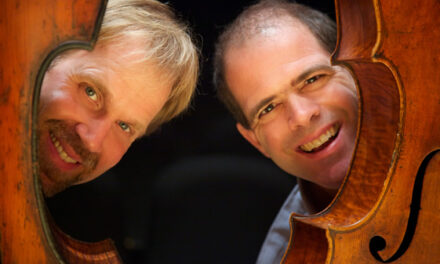Carolina Performing Arts has demonstrated over and over this season that it is playing in the big leagues, especially with its large number of commissions and premieres associated with “The Rite of Spring at One Hundred.” This week sees two performances by one of the great European contemporary dance companies, Nederlands Dans Theater 1. On April 3, NDT1 danced the US premiere of Chamber, co-commissioned by CPA, a meditation (if something so active can be so called) on the music and dance of The Rite of Spring, one hundred years later. NDT will take the program to New York’s Lincoln Center next week.
Chamber is the freshest, least labored, reconsideration of the influential Rite that we have seen during this saturation season. CPA also co-commissioned the music for it from British composer Joby Talbot (b. 1971), who wrote the vividly textured Chamber Symphony with much back-and-forth discussion with NDT choreographer Medhi Walerski. Talbot has written several works for dance companies, and he understands well what makes music danceable — at least by superb dancers at the top of the achievement pyramid, like those of NDT1.
Although the score (30 minutes total) is marked Allegro insistente/Adagio minaccioso/Scherzando con malizia/Adagio risoluto—allegro brutale, the work as a whole feels less violent than Stravinsky’s Rite. Talbot’s Chamber Symphony is certainly explosive, and rises again and again to overwhelming pitches of sound and emotion, but it lacks the martial qualities that make The Rite so terrifying. The raw power of Chamber is more purely sexual. As in almost every dance version of The Rite, the stage is filled with a large number of dancers in continual intense motion, but in this dance, the interplay between individual and community makes this work distinctively 21st century. Walerski quotes Nijinsky at times, both directly and obliquely, but the balance of power between group and individual is quite different in Walerski’s choreography. Talbot has written that he and Walerski “wanted to make a piece that explores the limits of the dancers’ physicality, seeing in this a parallel with the death of the sacrificial victim — the ‘chosen one’ at the end of The Rite of Spring…” This shift to the dancers choosing, rather than being chosen, is key to the music and the motion, and places Chamber squarely in the now. The dance contains many motions that I saw as growth, a bursting forth from the seed, and the sounds are sometimes like this, too — something regenerating, genetically altered but of recognizable parentage. The music, which had its world premiere along with the dance in Den Haag in October, 2012, is not yet available on recording, nor is there a complete video of the dance available, but you can get a taste of both from this rehearsal video. And — sad to say — although NDT will return to Memorial Hall on April 5, they will not be performing Chamber again here.
Chamber was the centerpiece of the evening, but the program’s other two dances were also jaw-dropping and eye-popping. Jirí Kylián’s Memoires d’Oubliettes (2009) led off. Dark, theatrical, sculptural and cinematic in addition to being kinetic to the highest degree, this work gets very frightening at times but is utterly mesmerizing. As we like to say around here, the past isn’t over, it isn’t even past. You can sweep it up, but it falls on you again, clattering like the glinting, empty, aluminum cans that rain from above just before the backdrop screen jitters from gray to black.
The evening closed with Speak for Yourself (1999) by Sol Leon and Paul Lightfoot (music by J. S. Bach and Steve Reich, layered). Nothing here to not like. A gorgeous young man in next to nothing appears. From a crouch, he suddenly opens his thighs, then claps them closed — and smoke puffs from his back. After a long virtuoso solo producing more and more smoke (he never turns his back to the audience) he retreats upstage to stand under a cone of downlight while other dancers emerge from the shadows and do lithe and powerful things alone and in pairs. Eventually dancer one joins them, but he leaves his smoke-maker behind, seemingly hanging in air, puffing away. As you are trying to get your mind around this, the rain begins, a gentle spring rain, soaking the dancers; beading and puddling on the stage. The dancers leap, slide and twine together in a world of smoke and water in a tour-de-force of prowess that is sure to keep this work in NDT’s repertory for many years to come.











